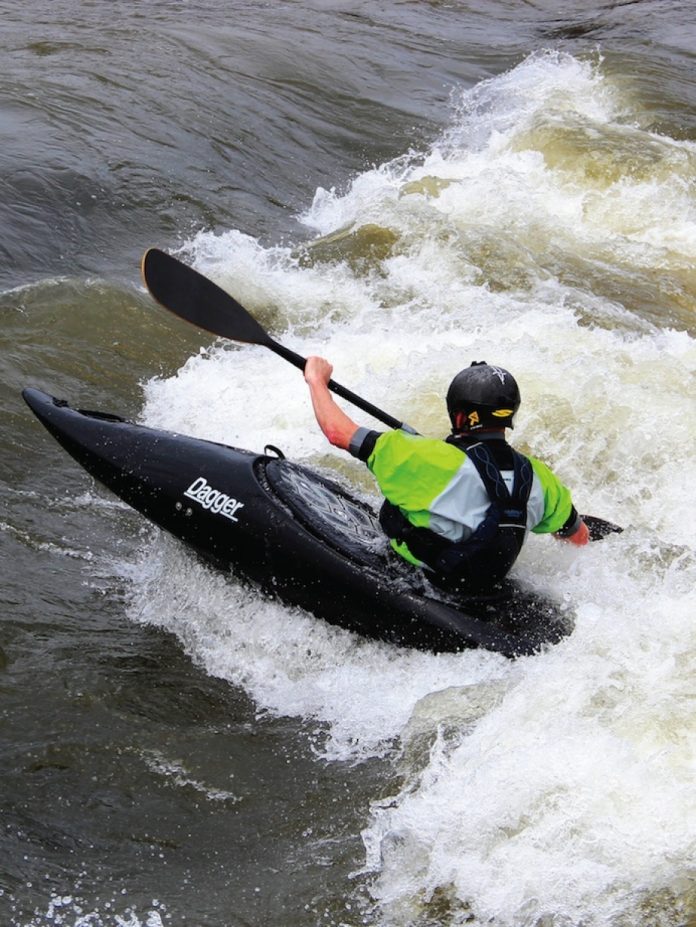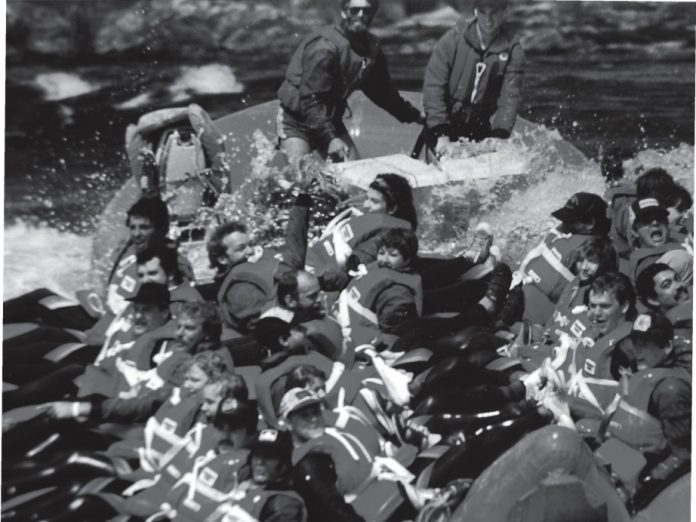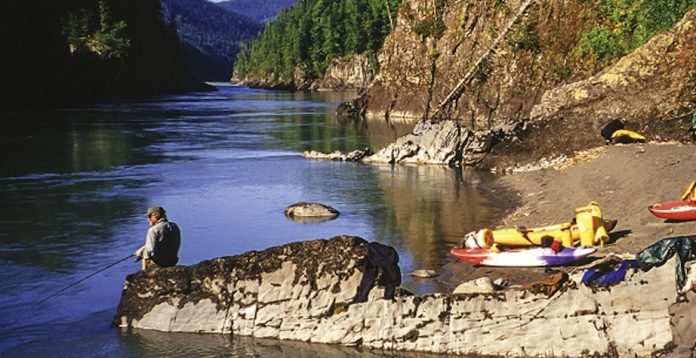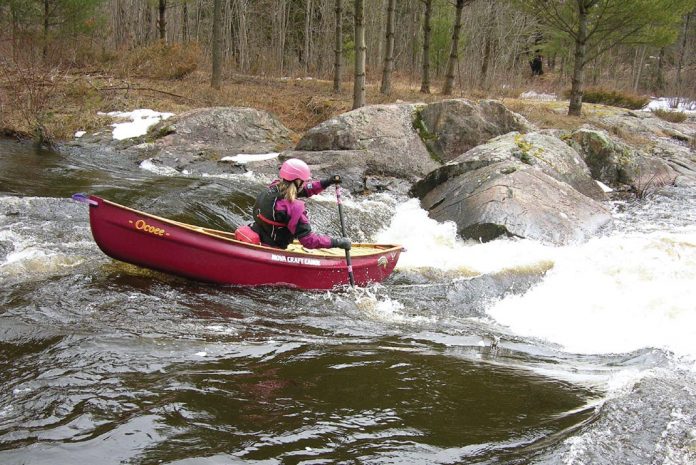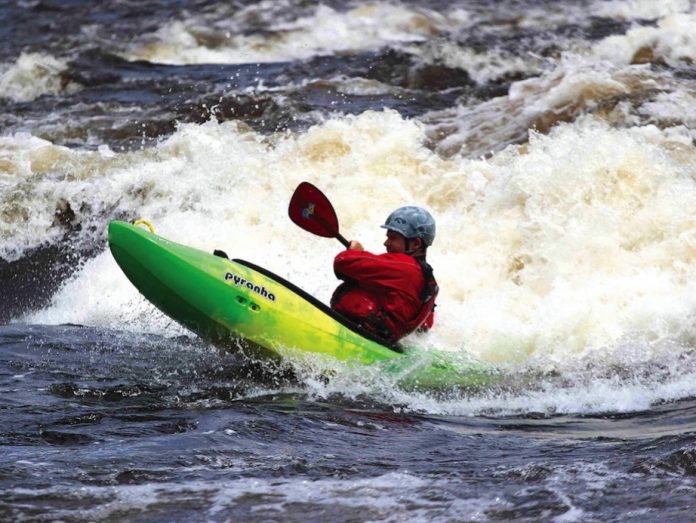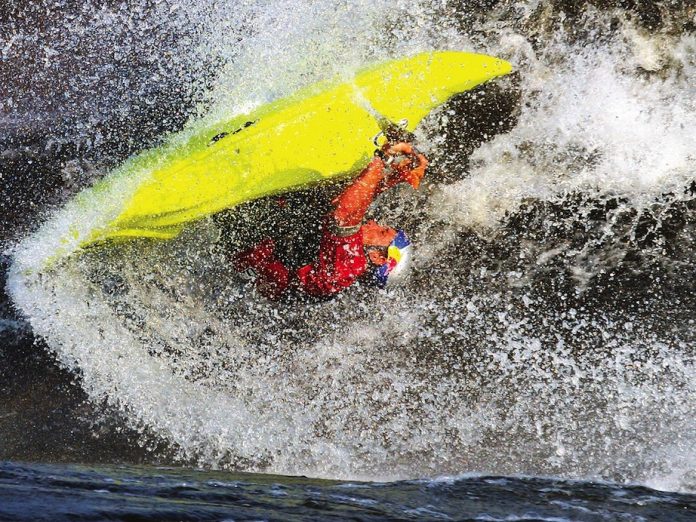Luke Hopkins shows Rapid Media founder and publisher Scott MacGregor a few of the paddles for kayakers in the Accent lineup and tells us that the next winner of the Worlds might be wielding one! From Rapid Mag TV.
Dagger Re-Releases the RPM
If you were born in 1997, you’re eligible to get your driver’s license this year. You also just missed the Summer Olympics in Atlanta, the cloning of Dolly the sheep and The Spice Girls’ first album, Spice. Perhaps most importantly, you missed the 1996 release of the most successful whitewater boat of all time—the Dagger RPM.
Not to worry, 16-year-olds (and everyone else), history is repeating itself with the re-release of the boat Rapid magazine readers voted the Most Revolutionary Whitewater Boat of All Time.
Short for Radical Play Machine, the RPM changed the river running game. “Paddlers wanted a kayak that guaranteed them access to all the latest freestyle moves in more spots on the river,” explains Marc Lyle, the RPM’s original designer. “We were assigned with the mission of delivering this design with one additional aspect in mind—it had to be a boat that everyone could paddle. The result redefined playboating as we knew it.”
Within the first year of launch, Lyle went on to sweep the competitive freestyle circuit with six wins and four second-place finishes in the 10 comps he entered.
“Many people have been going back to the original RPM and running their local rivers,” says Dagger Product Manager, Scott Stewart. “There’s limited availability of the original RPM, so it’s the right time to allow those not lucky enough to already own one to experience this classic style of boat.”
Classic indeed. The RPM’s flat stern allows huge squirts. Its displacement hull also has an uncanny balance of stability and rollability. These forgiving characteristics are what make the boat so beginner-friendly.
Dagger left the old-school favorite’s hull alone, but it will be offered with updated outfitting. The snazzy thermomolded seat, a bulkhead footbrace system and adjustable hip pads and thigh braces way outperform any outfitting available back in the days when MTV actually played music.
The RPM is available for a limited time through retailers now. Just like in 1996, it comes in one eight-foot 11-inch, 60-gallon size. No word yet on the re-release of the bigger RPM Max.
Download a couple episodes of Friends and grab a case of Snapple iced tea for the full 1996 après-paddle experience. If you’re only 16, these references are probably lost on you. Fortunately, you can pick up your own shiny new RPM and stop wondering what it was like to paddle in the nineties.
This article appeared in Rapid, Summer/Fall 2013.
Babine-Skeena Rivers Trip
Beginning in the Babine Mountains, this trip offers mountain scenery, canyons and wildlife encounters. Put in at Nikitkwa Lake and take out four to six days and 130 kilometers later in Kispiox. Bring your fishing rod—the Babine River is one of the richest salmon spawning areas in the world. Volume on the Babine is medium but expect larger volume on the Skeena with excellent play waves. A solid class III+ run.
Local Beta
Check out Smithers’ paddle shop, Aquabatics (www.aquabatics.com), for last-minute trip needs. The wildlife in the area is rich—expect to see eagles, salmon and deer. Count yourself lucky if you see moose, wolves and lynx. This is one whitewater trip where you’ll want to bring bear spray.
This article originally appeared in Rapid, Summer/Fall 2013. Download our free iPad/iPhone/iPod Touch App or Android App or read it here.
Here’s Why The Ocoee Is Nova Craft’s Best Open Boat
Before we talk about the Nova Craft Canoe Ocoee, let me first take you back in time to 1993. I was lined up for my instructor course’s final run at the top of Chalet Rapids. I had the option of running the course director’s then new Dagger Ocoee or doing my solo exam run in a 17-foot Prospector.
All I’d heard for the past 10 days of the course were the instructors talking about how edgy the Ocoee was. How it was an advanced paddler’s boat. And it was then. At the time, the hot boats had been the Dagger Genesis, Impulse and Prophet and the Mohawk Viper 11—all very soft and forgiving by comparison. I admit it—I was afraid of the Ocoee. And with a pass or fail run ahead of me, there was too much at stake.
Nova Craft Canoe Ocoee Specs
Length: 11’3″
Width at gunnels: 25″
Width at waterline: 27″
Depth at bow: 21.5″
Depth at center: 15’5″
Depth at stern: 26″
Rocker: 5.5″
Capacity: 500 lbs
Royalex: 38 lbs
Royalex Plus: 44 lbs
Two years later I picked up a well-used Ocoee and learned to paddle it. As my skills improved, I learned to love it. It was the right boat at the right time.
By ‘99, in Rapid’s first open canoe shootout, all the intermediate open boaters wanted to be in the Ocoee, but most admitted they were still uncomfortable with its abrupt transition from primary to secondary stability. Like most flat-bottomed, hard-chined boats, the Ocoee doesn’t like to stay level; it wants to be tilted one way or the other. And that takes some getting used to.
The Ocoee set the standard for front surfing and technical paddling. Advanced paddlers love slicing across currents and truly carving deep into eddies. The Ocoee was also the first production boat that allowed advanced paddlers to offside tilt and engage outside edge to pivot turn an open canoe.
One of the best things about the Ocoee is how much you can play with its shape. I cut the top down, removing some of the Ocoee’s prominent sheer—the swooping up at the bow and stern. Then I narrowed the gunwales, rounding the bottom and sharpening the chines, making for faster and sharper carving.
Want it even faster? Andrew Westwood did. For slalom racing he played around with the shape, drawing the bow radically narrower than the stern. Westwood’s race boat was shaped like an arrowhead.
For creeking and rodeo (it was called rodeo then), Mark Scriver, Paul Mason and others sawed a foot or so out of the center and bonded the bow and stern back together. This modification was so successful, designer Frankie Hubbard ran with it to design the Pyranha Prelude—now the Esquif Prelude.
Nova Craft offers their Ocoee in either a Royalex or Royalex Plus, or what we used to call Royalite and Royalex. You have three gunwale options: vinyl, ash trim or bare hull.
Instructor Gail Shields, whose Bell Ocoee was used to build the Nova Craft mold, says she hasn’t been babying her lighter Royalite version and it’s holding up very well. She opted to install her own gunwales and Mike Yee Outfitting to create a hot rod of a canoe, weighing in at a crazy light 39 pounds. In fact, she needs the extra weight of nylon airbags so the boat will be legal in the rec class at ACA slalom events.
So, should you try Nova Craft’s version of this 20-year-old design? I think so, and so do Rapid readers. The Ocoee was voted favorite solo open boat of all time in our 2012 best boat survey. And if you still don’t think you’re ready for an Ocoee, no trouble, in the meantime Nova Craft makes a fantastic Prospector.
This article was first published in Rapid‘s Summer/Fall 2013 issue. Subscribe to Paddling Magazine’s print and digital editions here , or browse the archives here.
Scott MacGregor is the founder and publisher of Rapid. For the record, he passed his solo instructor level in the Prospector.
Gail Shields on the river with the first production Nova Craft Ocoee. | Photo: Brian Shields
LA River Welcomes Back Paddlers
Encased in a concrete straightjacket for more than 70 years, the Los Angeles River has been forgotten about by many. But a newly reopened four-kilometer stretch of water is pulling paddlers back to the river and allowing locals to reconnect with nature.
“People are astounded when they find out that we have a river in LA and that we were founded on a river, [but] now, there’s more and more interest in calling it a river again and bringing it back to life,” said Thea Mercouffer, director of Rock the Boat, a documentary that followed her husband, George Wolfe, as he led an expedition down the entire Los Angeles River in 2008 to prove that it is both navigable and worth protecting.
“[The Los Angeles River] provides this unparalleled experience of being in one of the most urbanized, cemented areas in the country while also being in nature. It has just class I or II rapids so it’s not a challenge for paddlers, it’s more of a novelty,” said Mercouffer. “To be in a tiny little boat surrounded by trees, and then above the trees are the power lines and beyond the power lines a city, it’s just really a surreal experience. It makes it that much more fulfilling.”
The Los Angeles River has been blocked off from public use since the late 1930s, when a massive flood left behind a path of death and destruction. The U.S. Army Corps of Engineers were called in to control the water with channels and flood control dams to prevent any possible floods in the future from having the same effect. But almost every year the river is consistently calm and doesn’t reach the high levels the concrete banks protect the city from, so the engineered river gets primarily used as a set for Hollywood movies—most famously to film car chases.
Since Wolfe proved the river to be navigable, it now falls under legal protection and local groups are arguing that the public should be allowed to once again use their river. The four-kilometer stretch between Fletcher Drive and Steelhead Park that opened on May 27 is a small step with a big impact, since it represents the first time boating has been officially allowed on the Los Angeles River in 80 years.
Mercouffer said that there are people taking advantage of the new water access everyday and that new river tours book up in just minutes, but it’s a slow process to get the city council to expand on the river.
“I think there’s a very, very strong disconnect between what the people are ready for and what their representatives think the people are ready for,” she said.
“[Preservation of the Los Angeles River] is an idea that, rather than dying down, is spreading.”
To learn more about Rock the Boat, visit www.rocktheboatfilm.com or for more information about the rules of the river go to www.lariverrecreation.org.
Pyranha Nano River Runner Review
It’s always a gamble when mixing design features together to come up with something new and exciting. Ideas that sound good on paper don’t always translate into success in the real world. Bassadors (a basset hound crossed with a Labrador retriever), the Ford Ranchero and McDonalds’ Land Sea Air burger are just a few unsuccessful mashups that come to mind. Fortunately, some get it right and create a product greater than the sum of its parts—this is the case with Pyranha’s new Nano.
We got our first glimpse of the Nano at Outdoor Retailer last summer, where Pyranha designer, Rich Taylor, confided to us that, “The hull is really the key.”
Flipping the boat over, he filled us in: “What we’ve done is combined three successful boats—the Shiva, the Jed and the Burn.” Line up all of these boats and you can clearly see the Nano truly does have a bow like the Shiva, Jed-like rails and a stern that takes lines from both the Shiva and Burn. The on-water result is a stable and playful ride. This kayak’s wide, semi-flat hull provides a rock-solid platform that…
This article originally appeared in Rapid, Summer/Fall 2013. To read the rest of the review, download our free iPad/iPhone/iPod Touch App or Android App or read it here.
Freestyle Move: Helix
Ten years ago, I was hanging out in a bar with some mates in Zambia, using a Mosi Lager coaster to work out a new move. The following morning, I paddled down to the Zambezi’s Rapid 12B, dropped onto the wave and stuck the move first try.
Ironically, it was this wave—on this very day—that would have hosted the 2001 World Freestyle Championships had Spain not won the bid two years before. Too bad, the newly crowned helix would have had the judges scratching their heads!
A helix is an upside down spin where the boat does a 360-degree rotation on two of its three axes. It’s basically an extension of an aerial flip turn. The hardest part is figuring it out in your head.
1. Begin at the top of a fairly large, fast wave.
2. Speeding down the face, stern rudder to turn the boat and initiate your spin momentum. A slight bounce at this point helps.
3. Once your boat is pointing across the wave, use an aggressive hip flick to over edge the carve—digging your upstream rail into the water, then leaning downstream. This will flip the boat over your head and send you airborne. Lift your paddle out of the water.
4. It’s at this step that the helix and flip turn diverge. Aggressively twist your body into the spin to continue rotating the boat on a horizontal plane.
5. As the boat comes around a full 360 degrees, switch active hands and grab the water with the opposite blade from your stern rudder. This is the key to finishing the horizontal rotation of the boat and rolling you upright. You should land flat and facing upstream.
People often mistake a good flip turn for a bad helix. To helix, the stern of your boat must not touch the water as it comes around on the upstream side. If it catches, your bow will come over your head vertically—that’s a radical flip turn.
This article originally appeared in Rapid, Early Summer 2011. Download our free iPad/iPhone/iPod Touch App or Android App or read it here.




